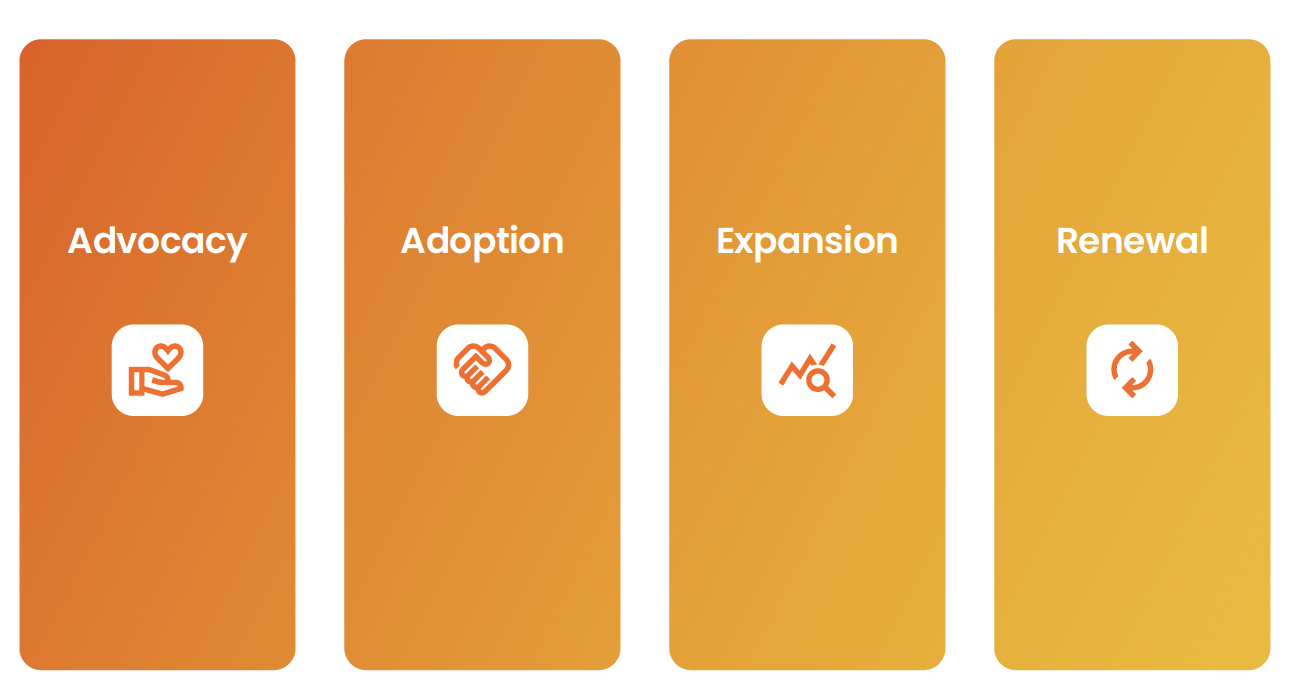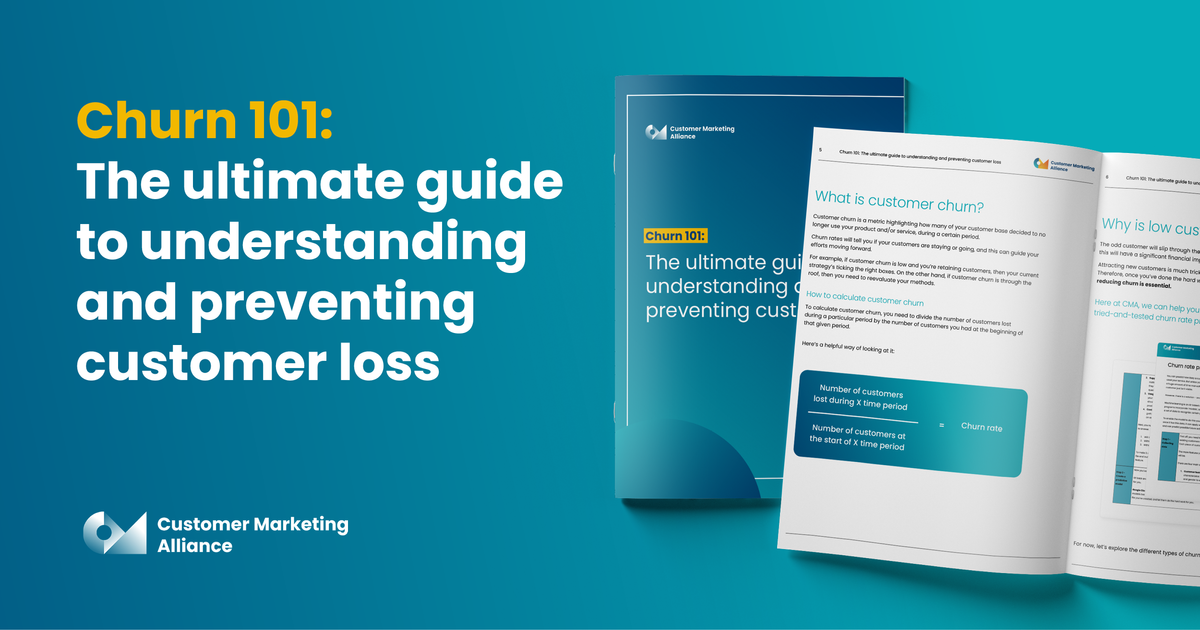Getting started from scratch is never easy. At first, building your customer marketing function may seem like an overwhelming task to take on. But we've got your back. Keep these key ideas in mind, and you’ll nail it the first time around.
In this article we're covering:
- Stage one: Set clear objectives
- Stage two: Identify available resources and personnel
- Stage three: Understand your platform and services
- Stage four: Set up lines of communication
- Stage five: Build the four pillars of customer marketing
Stage one: Set clear objectives
What do you aim to achieve?
Understand the WHY.
There are several stages of development before you finalize your plan and put it into action. A high-up stakeholder has likely given you a brief on why this team is being put into place. Their ‘why’ may be that they want to improve customer retention or increase customer lifetime value, or it may be something as simple as wanting to get a customer marketing strategy off the ground before your competitors do.
Where does customer marketing overlap with existing departments?
Historically, other departments, like sales and customer success, will have handled many aspects of customer marketing, since it’s still a relatively new practice. Therefore, there’s a lot of overlap between these positions.
Customer marketers handle the customer relationship that product marketing begins and customer success monitors. These departments carefully coordinate the customer journey at each step of the way.
Where customer marketing differs from these departments is in how the relationship between the business and the customer is handled. Customer marketing is not so often about the product itself; you aren’t trying to sell the customer something. Nor are you just asking for feedback about your product.
Collaborating with other teams throughout the process can minimize siloing and conflicts before the planning stage gets too far along. This relationship will also benefit all parties involved, as it’ll support sales and customer success to achieve their revenue metrics.
Stage two: Identify available resources and personnel
To find and identify available resources and personnel to set up a brand-new customer marketing function, consider the following avenues:
- Internal
- Human Resources (HR)
- Marketing
- Sales
- Employee Skills Database
- Training and Development
- External
- Job Boards
- Recruitment Agencies
- Freelance Platforms
- Consultants and Advisors
- Networks
- Industry Groups
Internal departments:
- Human Resources (HR): HR can provide information on existing employees who might have relevant skills or interests in customer marketing roles.
- Marketing: Collaborate with existing marketing teams to identify personnel who can transition or contribute to customer marketing efforts.
- Sales: Sales teams often have valuable insights into customer behavior and can contribute to customer marketing strategies.
- Employee Skills Database: Many companies maintain databases or profiles of employee skills, expertise, and interests - so utilize these resources to identify individuals with relevant skills for customer marketing.
- Training and Development: Offer training programs or workshops to upskill existing employees who show interest in customer marketing roles.
Professional networks:
- LinkedIn: Search within your organization's LinkedIn network for individuals with marketing experience or expertise relevant to customer marketing.
- Industry Groups: Participate in industry-specific forums, groups, or events to network with professionals who may be interested in joining your customer marketing team.
External recruitment:
- Job Boards: Post job listings on popular job boards or specialized platforms targeting marketing professionals.
- Recruitment Agencies: Partner with recruitment agencies specializing in marketing roles to help identify qualified candidates.
- Freelance Platforms: Consider hiring freelance marketers or consultants with expertise in customer marketing on platforms like Upwork or Freelancer.
- Consultants and Advisors: Engage with external consultants or advisors who specialize in customer marketing to provide guidance and support in setting up the function.
By exploring these avenues, you can effectively identify available resources and personnel to set up a successful customer marketing function within your organization.

Stage three: Understand your platform and processes
This may be an obvious place to start, but because it is, it often gets overlooked. Though you may be working with these procedures and practices day in and day out, it doesn’t hurt to sit down and analyze them in more detail.
No work setup is perfect, so there’ll ultimately be some best practices that fall by the wayside or get ignored in favor of more important ones.
So, before you begin making any big changes, start with what you have. Sit down and go through each platform, vision, service, procedure, and best practice. Become familiar with them again.
This is also great practice for any customer marketers you’re currently onboarding. Make sure to include this familiarization practice in their initial training.

Stage four: Set up lines of communication
When establishing your customer marketing department, it’s vital that you set up a regular cadence of communication between yourself and the departments you’ll work more closely with.
For customer marketing, this is more likely to be marketing, sales, customer success, and product teams. Make sure they understand exactly what your role is within the business, and learn about their current processes too. This is a good way to start building relationships with internal stakeholders.
Stage five: Build the four pillars of customer marketing
These four pillars are what make up and define customer marketing. It’s important to assess these pillars when establishing your strategy and build them to fit your company’s brand and goals.

Advocacy
Identify who your current advocates are and then use customer segmentation to categorize them by geography, personas, location, company size, etc. Then look at your business' current action plan for obtaining advocates, whether you have a plan at all, and how people’s acts of advocacy are monitored and recorded. This will help you identify any parts of the process that are currently lacking.
Customer communications and adoption
Consider what the key vision for your customer marketing plan is, and how this will inform your messaging strategies. Identify the key pain points for your target markets you and your products aim to solve. Make sure this is reflected in all customer communications.
What is the cadence for this project? What milestones will your marketing team aim to meet and when? How does each stage flow into the next?
Expansion
Look at what types of programs and campaigns have worked for your business in the past. Identify the specific trends that resonated with your target audience and those that didn’t.
Do some account mapping of your target accounts, too. Use this technique to understand key accounts (advocates, for example) and increase your reach among new and existing customers. This is another area in which customer segmentation can come in handy, by helping you identify important characteristics of your target audience.
Use cross-departmental collaboration to assist your research by talking to sales about the asset types they favor the most. This could be videos, social media mentions, case studies, white papers, presentation slides, and more.

Renewal
This is an area in which customer marketers consider churned accounts and accounts that have the potential to churn soon. Gathering data about these accounts, and getting access to those user behavior metrics, can go a long way in identifying specific pain points that your customer marketing plan can then aim to solve.
Use in–product surveys and Net Promoter Score (NPS) surveys to get a lay of the land, and see how your overall customer base feels about your brand, and to determine how likely they are to remain loyal.
And, again, make sure to assess your current renewal strategies. This will give you content you can use to begin building and improving your own renewal program.

The next 31-60 days
This article was just a short snippet from our comprehensive playbook taking you though the first 90 days of a customer marketing set up.
We didn't reveal everything in this article, so go ahead and grab yourself a free copy to get all the unlimited tips and tricks! Here's a breakdown of the structure:
| DAYS 0-30 | DAYS 31-60 | DAYS 61-90 |
|---|---|---|
What are you waiting for? Build your strategy with the most potent plans, methods, and approaches, to ensure maximum efficiency from day one.


 7 min read
7 min read
 Follow us on LinkedIn
Follow us on LinkedIn




